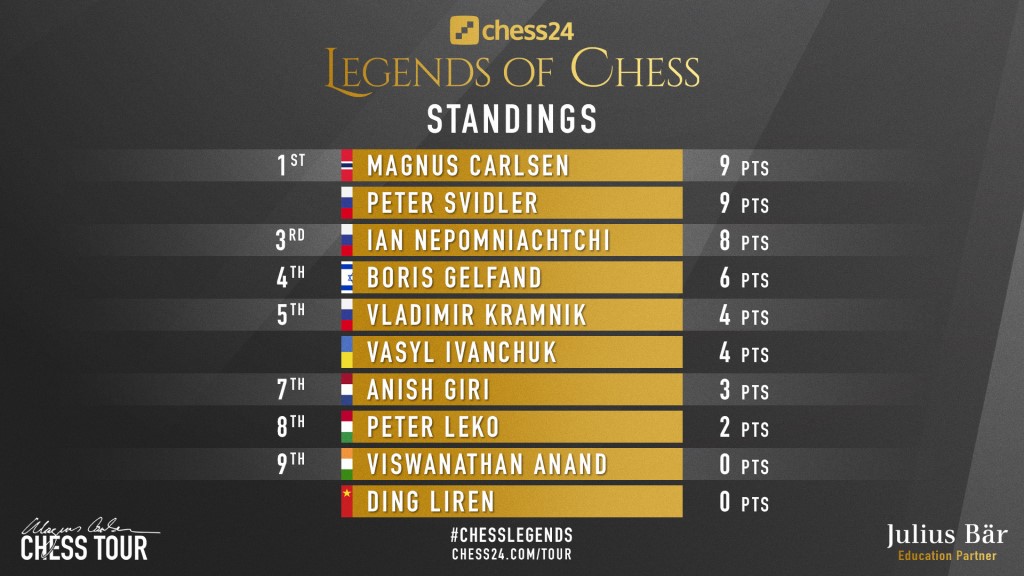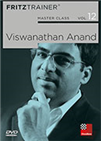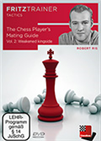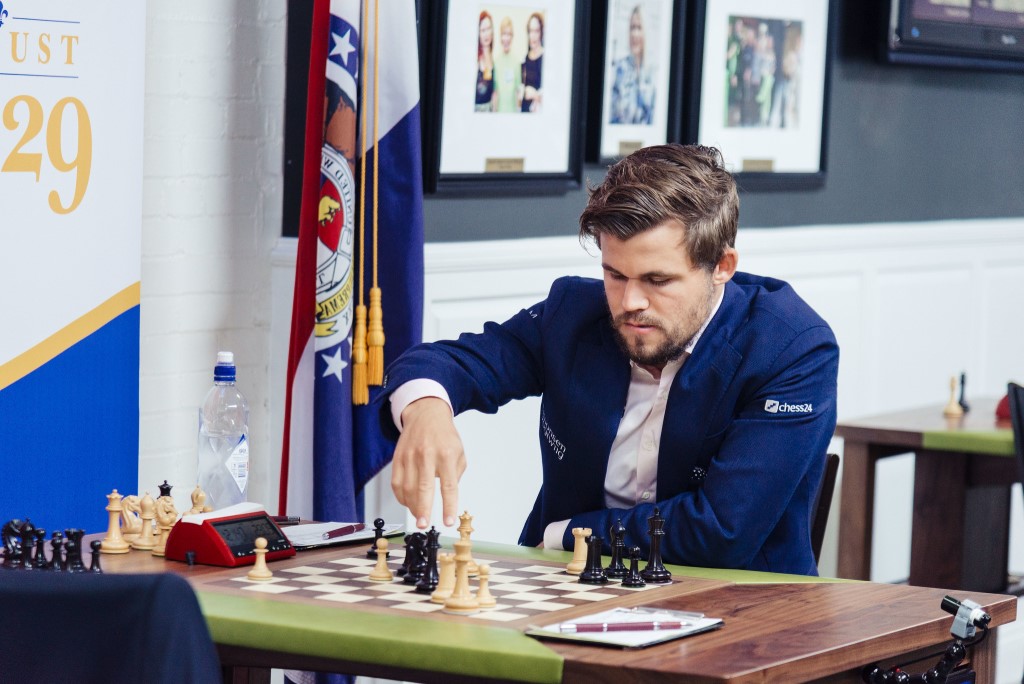Kramnik beats Anand
Is Magnus Carlsen already a legend? For most of us, he is, but the name of the tournament has more to do with the presence of the older illustrious participants. If we go by that logic, it seems likely that two of these legends will reach the semifinals, despite the presence of four top-notch younger stars — after three rounds, Anish Giri and Ding Liren are placed in the bottom half of the standings table, while Peter Svidler and Boris Gelfand are in the top 4.
Right below Svidler and Gelfand, tied in fifth place, are Vasyl Ivanchuk and Vladimir Kramnik. The latter obtained his first mini-match win of the event on Thursday, when his 2½:½ victory over Vishy Anand included a wild win in game 1. Kramnik will face another previous World Championship contender in round 4 — Peter Leko.
Speaking of Leko, the Hungarian GM lost a second close match in a row. In round 2, he had good chances to beat Svidler but ended up losing, and the story repeated itself in round 3 when he played against Carlsen. The resilience of the world champion helped him save a couple of positions and then get a deciding win in game 4.

Click to enlarge
Kramnik 2½ : ½ Anand
After winning the reunification match for the World Championship in 2006, Kramnik played two back-to-back World Championships in 2007 and 2008. In the former, which was an eight-player double round robin, he finished second behind Anand; while in the latter, following a previous agreement, he faced Anand in a best-of-12 match, which was again won by the Indian.
The old rivals (and friends) kicked off their round-3 matchup with a stunning game. Kramnik played the French Defence, and a closed pawn structure soon showed up on the board:
 This DVD allows you to learn from the example of one of the best players in the history of chess and from the explanations of the authors how to successfully organise your games strategically, and how to keep your opponent permanently under pressure.
This DVD allows you to learn from the example of one of the best players in the history of chess and from the explanations of the authors how to successfully organise your games strategically, and how to keep your opponent permanently under pressure.
The material is even and it’s a matter of who can create threats more quickly, given White’s army is concentrated on the kingside and Black’s pieces are congregated on the other flank of the board. Thus 34.Bg6 Nb3 35.Re1 Be8 and 36.Nf5 leaving a second piece en prise!
Here Kramnik erred with 36...fxg6 [36...Kc8 avoiding the knight fork from d6] and the game continued 37.Nd6+ Kc7 38.Nxe8 Kd7 39.Nd7 when White is clearly for choice.
Anand tried to make the most of his passed pawn in the ending with a rook and two knights per side, but was not precise enough against his famed opponent. Kramnik was defending against the promotion of the f-pawn while gobbling up pawns in the centre to create his own passers.
The position seemed to be balanced, until Anand faltered on move 52:
52.Nxe6+ gave Black the initiative [52.Rxg6 was the way to go 52...Nxg6 and only now 53.Nxe6+ Kd7 54.Nf4], but soon enough Kramnik returned the favour. The game continued 52...Nxe6 53.Rxg6+ d4 (now it’s Black who has the connected passers) 54.Ke4.
[Correct was 54...c2, although perhaps Kramnik feared 55.Rg7, threatening to promote with discovered check, but 55...Kb6 is more than enough to keep things under control for Black] 54...Re2+ 55.Kf3 Re3+ 56.Kg4 and the complex struggle continued.
Black’s c-pawn promoted into a queen, but White still had his strong connected passers on the e and f-files. Suddenly, Kramnik blundered:
 This DVD allows you to learn from the example of one of the best players in the history of chess and from the explanations of the authors (Pelletier, Marin, Müller and Reeh) how to successfully organise your games strategically, consequently how to keep y
This DVD allows you to learn from the example of one of the best players in the history of chess and from the explanations of the authors (Pelletier, Marin, Müller and Reeh) how to successfully organise your games strategically, consequently how to keep y
Black chose the wrong check with 62...Qd2+ [62...Qg1+ or 62...Qc1+ would have kept the balance] allowing 63.Nf4 when White’s pawns are too strong. However, Anand responded with the mistaken 63.Kg6 and resigned after 63...Qg2+.
[64.Kh7 Qxh3+ 65.Kg7 Qxe6] 0-1. We cannot blame the legends for not finding the most precise moves in a 15-minute game. It was a spectacular show nonetheless!
Anand could not recover from such a loss and ended up losing game 2 as well. A draw in game 3 gave Kramnik mini-match victory.
Carlsen 2½ : 1½ Leko
It is safe to say Leko outplayed the world champion in the three first games of their matchup. The biggest missed chance by the Hungarian was seen in game 3:
33.Re1 was too fancy a move [33.Qe4 or 33.Qe3, stepping away from the discovered attack on the queen were enough to keep White’s large advantage] 33...Nf3+ 34.Qxf3 Bxd4 35.Rxc4 and Black had enough counterplay to keep the balance.
Leko was ruthlessly punished for having missed his chances, as Carlsen defeated him in game 4 to win the mini-match.
Svidler 2½ : 1½ Gelfand
The clash of co-leaders saw Svidler getting a third straight 2½:1½ win in the tournament. The Russian scored in game 3, when Gelfand went all-in for a kingside attack with the white pieces:
White does not have enough fire power to break through: 33.g6 fxg6 34.hxg6 Qg7 35.gxh7+ Kh8 36.Qxg7+ Kxg7.
37.Bh3 Ng5 0-1. This win was enough for Svidler to keep up the pace with the world champion.
Ivanchuk 2½ : 1½ Ding
Ding’s woes continue, as he lost a third mini-match in a row, this time against Ivanchuk. The Chinese GM at least got his first win of the event (in a single game), but he went down in flames in game 4, when the Ukrainian genius caught him in a beautiful mating net:
 The attention will be paid to the castled king and in particular on ways of exploiting the weakened kingside. Several well-known themes, pawnformations and other attacking weapons are covered in 8 chapters.
The attention will be paid to the castled king and in particular on ways of exploiting the weakened kingside. Several well-known themes, pawnformations and other attacking weapons are covered in 8 chapters.
Ivanchuk found 23.Bxh7+ Kf7 [23...Nxh7 24.Qe6+ Kf8 25.Ng6#] 24.Nf5 Nxh7 26.Nh6+ and Ding resigned [26...Kf8 27.Qxh7 gxh6 28.Rg3 followed by 29.Rg8#].
Nepomniachtchi 2½ : ½ Giri
Much like Carlsen, Nepomniachtchi won a mini-match he could have easily lost in round 3. He had close-to-lost positions in games 1 and 2, but managed to win both times! Giri’s blunder in the second encounter was terrible:
Black’s 24...Qa5 in the previous move allowed 25.Ng5 and there is no way to stop White — 25...Rfc8 26.Qxh7+ Kf8 27.Nxe6+ fxe6 28.Bxg6 1-0. ‘Nepo’ drew game 3 to defeat his unfortunate opponent.
Links
























